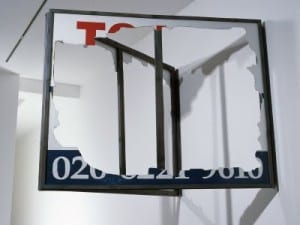In once again the world is flat., Steinbach investigates the hierarchy of the art object. Within the installation a household object sits next to an artefact from a museum collection and both are given equal stature. Steinbach explores the universality of acquiring and arranging things, looking at the ritual of this practice through the arrangement of found and made objects.
Scaffolding runs throughout the display, creating a shelf upon which donated salt and pepper shakers sit. Steinbach asked the public to donate these domestic items to the exhibition, to be displayed alongside his own work and artworks donated from major collections. This process of donation asks questions about ownership and personal connection to these kitsch objects.
The exhibition display moves them from the private into the public realm, through displaying these objects, personal connections and stories begin to emerge as meaning is carried through their former context. People innately arrange objects, put them on a shelf to create a tableau – it becomes a social ritual, one that is enacted whether in the home, or as part of a museum display.
The Serpentine has invited curators from a range of public and private institutions to select works from their collections to be displayed in the exhibition. Juxtaposing engravings from Durer, works from the V&A Museum of Childhood alongside everyday items, our notion of an object’s value begins to shift. This subverts the traditional hierarchy of objects and display, mixing what could be considered high and low culture.
The space of the gallery is dissected with scaffolding, open display systems and unfinished walls creating the exhibition architecture. Screw holes have been filled but not painted over; joints are left exposed to reveal this cultural construction. Galleries and museum buildings present an immaculate surface upon which to show cultural artefacts, but the classic white wall gallery space is abandoned, instead a modular system is employed to present the exhibition. This system of display peels back the construction of the space; the layers and reality of the gallery is revealed.
The architecture of the gallery space mimics a domestic interior; walls separate the space, breaking up lines of site, as if sectioned into domestic rooms. This intervention into the space leads the viewer’s navigation through the space. As you enter one room, you are faced with a chaise longue sat within a wooden box. This piece of household furniture repositioned within the gallery space highlights the public/private juxtaposition Steinbach constantly plays with.
Walls are partially covered in wallpaper to create an assemblage of different styles and patterns. Wallpaper is a cultural material that is embedded within a particular time and culture. The wallpaper becomes a backdrop to the objects, creating an engagement between the different planes and surfaces – from wall to shelf to the floor. The different strips of wallpaper change the context in which the work is viewed, highlighting how the flat surface can affect the viewer’s perception of the object.
The exhibition isn’t as much about what is presented, as thinking around the object and its cultural implications. The value of the object doesn’t matter; what matters in the installation is that they are part of our language, and the display allows them to overlap, to repeat and open up a dialogue. Once again the world is flat. looks at the fundamental human practice of collecting, displaying and presenting objects, opening up questions about how we form values and meanings of everyday and cultural artefacts. Through simple juxtapositions, Steinbach reveals the fine line between art, space and the things that surround us.
once again the world is flat. ran from 4 March – 5 May at the Serpentine Gallery, Kensington Gardens, London W2 3XA. For more information visit www.serpentinegalleries.org.
Rory Duckhouse
Credits
1. Haim Steinbach, Installation view, once again the world is flat. Serpentine Gallery, London © 2014 Hugo Glendinning




